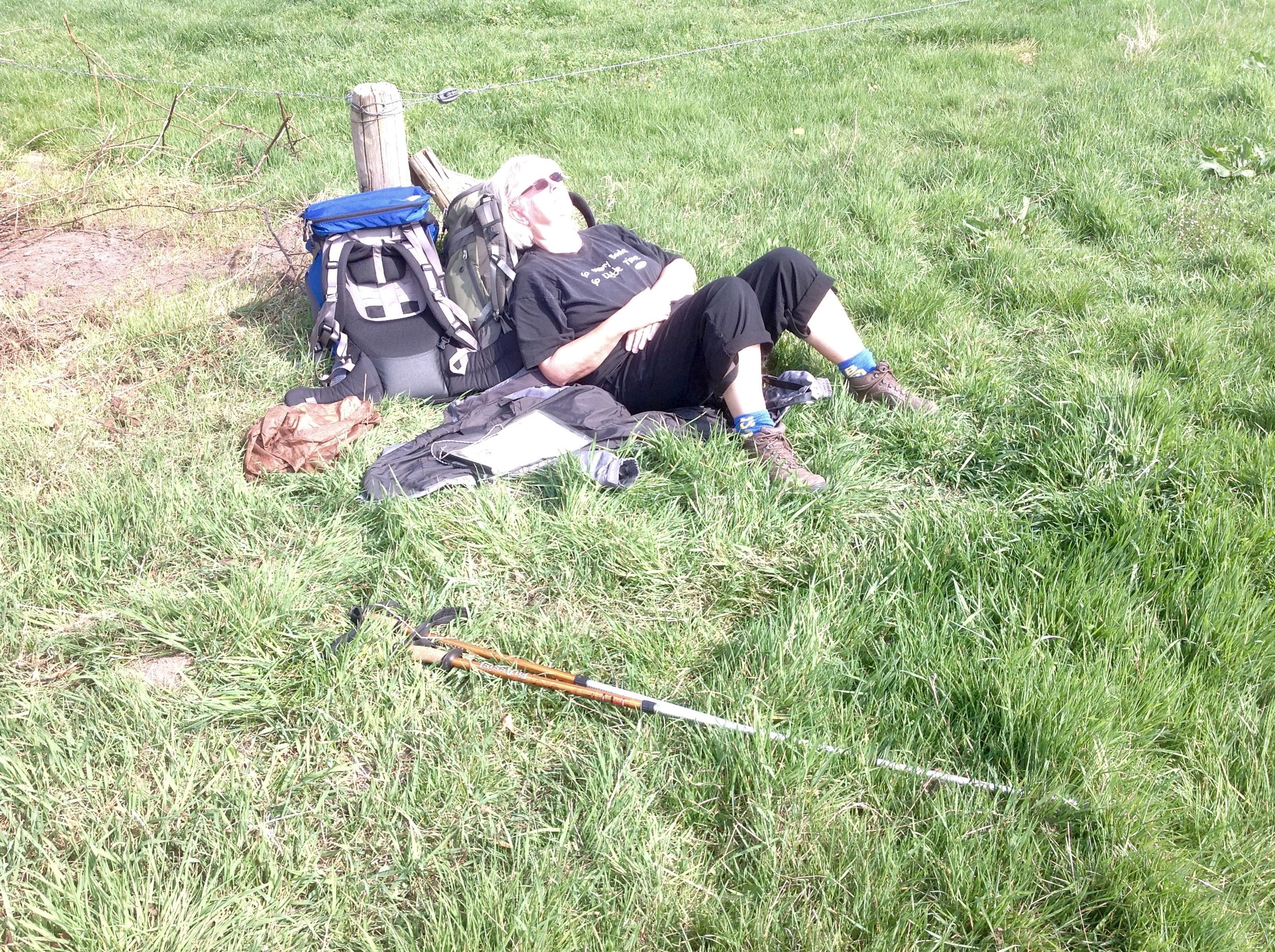My husband is an avid hiker. The longer the trail, the happier he is. He was trained in the army and at sports college. And he trained me well, too. But despite his best efforts, I have decided that long distance hiking is not for me. I would like to sip a coffee on a patio or take photos of the view while he hoofs on, leaving me in a cloud of dust. However, I do not want to deprive you of the lessons I learned across the trail.
As a sport, hiking is rapidly gaining popularity worldwide as ever increasing networks of trails sprout up everywhere. Here are some basic guidelines to help you on your way to a most painful experience you won’t want to miss.
You can’t just start walking so we’ll start with a discussion on equipment. For maximum benefits you will need specialized clothing that will cost you an arm as well as that leg that you will need for hiking.
1. Equipment
Boots. The first thing you will need to buy is proper footwear. Boots. The heavier the better. Ensure that your boots are at least one, and preferably several, sizes too small. An effective style for long distance hiking is the prison style boot complete with ball and chain. This will add memorable moments to your hiking experience. Buying lightweight, waterproof boots is no fun. Socks will cost you about 40 dollars a pair. The label will tell you that these socks are ‘wicking’ - this means they circulate moisture. Buying wicked socks for 2.- per pair has the same desired result.
I recently tried shoes that offer memory foam. This might come in helpful if you forget the way home. Your shoes might remember. They also promised ‘air cooling’. I pranced all over the store but did not notice any cooling effects. I think you have to wait for that until holes develop in the soles. Some boots promise to be waterproof but all staff will tell you that there really is no such thing. You walk into a creek, you get wet feet. One way to solve this problem is by hiking in gum boots or hipwaders.
You will also need to select a jacket that allows moisture to be absorbed and retained both in and outside. Select shorts or capris that can be rolled up to expose as much flesh as possible. Blackflies, mosquitoes and brambles are all eagerly waiting for you along the trail. Don’t disappoint them by buying insect repelling clothing. People repelling clothing might be a better choice in some locations.
You will also need to select a suitable backpack. If you hike long distances you will need to decide on the size best suited for your particular trek. I recommended the largest size possible. You decide the proper size by filling the pack with boulders, beyond capacity. If you cannot possibly lift it with both hands, it is just the right size to carry for the next several weeks.
You will notice that the size of a backpack is referred to in liters: 18, 30 or 40 liters are the most common sizes. This means you have a choice: you can either fill your backpack with stuff or with 40 liters of beer or wine. Based on experience I recommend the latter.
A backpack should have a waist strap. The purpose of the waist strap is to increase pressure on the bladder while hiking.
A comfortable spot for a lunch break, Israel.
2. Food
If you do decide to take ‘stuff’, you might want to include food. When hiking quaint trails in Europe, you will encounter many lovely patios, coffee houses and wineries. However, since this is Europe they will be closed because:
it is Sunday,
it is Monday,
it is Wednesday afternoon
it is a special holiday
the owner is on holidays
a combination of the above.
Commonly recommended food to bring along on a long distance hike is freeze dried. This simply means it is a tasteless, processed blend of oats, barley and other indigestible dry flakes. Freeze dried food comes in a variety of shapes, the most popular being bars or pellets. One bar will cost more than a grande latte. The advantage of pellets is that, if you have any leftovers at the end of your journey, you can use them as cattle feed.
The best part of the hike.
Select the most desirable type of freeze dried bars by offering one to your dog. If he refuses, you have found the kind you want to take along on your long distance hike.
3. Map
Be sure to look for a proper map or trail guide. Generally a map is at least ten years outdated. This poses no problem since any trail system worthy of its existence, has an accompanying website. The website will give you any changes and updates to add to your book. Print off all 86 pages to carry along. Any pages you don’t need anymore can be used during sanitary stops (you didn’t really expect toilet buildings and 4 ply out there, did you?).
If, at any point during your hike, you get bored I recommend holding the map upside down for a few kilometers. This adds greatly to the excitement. You could decide not to carry a printed map and to use GPS. However, there may not be any reception about there… In which case you will be left to your own, blank devices.
Ignore the tiny striped trail markers. Follow the Chianti sign!
Many LDT (long distance trails) have, in addition to maps, an easy to follow system of markers. These consist of faint, barely visible paint stripes on trees or posts. For maximum enjoyment select a trail that runs near, and is often intersected by another trail system with similar signs: white and red stripes mixed with faint yellow and red stripes works great. The more often these trails cross, the better your changes of following the wrong trail for a while. The other thing that adds to the fun is when trees with signs on them have been cut down, allowing you to wander aimlessly for hours before spotting another faint white stripe on the trunk of a birch tree.
4. Accommodations
Hostel, Spain
Unless you chose to sleep in a tent the size of a ziploc bag, you will have to book hostels along the way. A hostel offers an inexpensive place to sleep to the weary hiker. The inexpensive bed entails a creaking bunkbed, sometimes with sheet, blanket and lumpy pillow. I recommend a bottom bunk since the top bunk has no ladder and no sides. Save these top bunks for entertainment. Hikers who arrive after you will have to hoist themselves up there. If you are lucky you can observe them tumbling down in the dead of night. A string of swear words will follow.
Most hostels have beds for up to 40 people per room. This increases your changes of no sleep at all since at least 30% of your fellow hikers will snore loudly, have nightmares - no doubt of hiking LDT - and will happily leave their very smelly, sweaty prison style boots next to the head end of your bunkbed. As a rule, 80% of any female fellow hikers will have to get up at least twice during the night to use the bathroom. These were the ones with 40 liters packs.
5. Terrain
Australia’s Cape to Cape Trail
When selecting the terrain for your your hike, be sure to pay attention to the type of vegetation and weather conditions. 40% chance of showers will likely mean a nonstop drizzle. This also increases your chance of mosquito encounters.
The best trails have endless sets of staircases like this one in Nazareth.
Knee high thistles and brambles are recommended. What else are you going to complain about afterwards? We have also tried beach trails. These gave you an opportunity to wade through ankle deep soft sand that slides away with each step. Train for these trails by going up down escalators in your home city.
6. The Social Aspect of Hiking
At night, in the hostel, it is recommended that you make contact with fellow hikers. The purpose of these social encounters is to compare the size of mosquito bites, the numbers of times you were lost and wandered aimlessly and the spots along the trail where you waded knee deep in cow paddies or mud puddles. Do not, under any circumstances, discuss the appealing scenery, the solitude of the trail or the thrill of being in nature.
Do, however, pay close attention to any other trail LDT systems recommended by these experienced hikers. Take notes. This will ensure many more years of suffering. Unless you took my advise on backpacks and filled yours with 40 liters of wine.
P.S. If you are still not convinced that long distance hiking is for you, be sure to watch this movie with Robert Redford, based on Bill Bryson’s book A Walk in the Woods:
https://www.youtube.com/watch?v=cOF2LIAp9bw
It will show you that all I told you is absolutely true. But if you still insist on suffering through a long, long hike (during which you might realize that there is peace in solitude and nature), read more on long distance hikes we’ve done:
Australia’s Cape to Cape Trail












